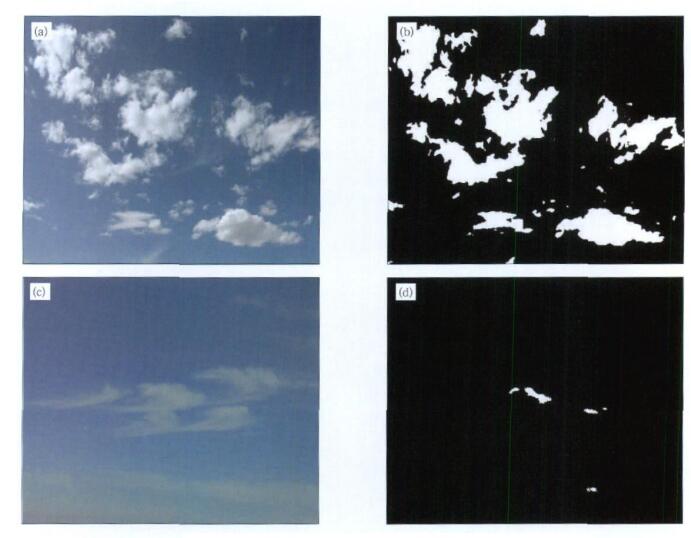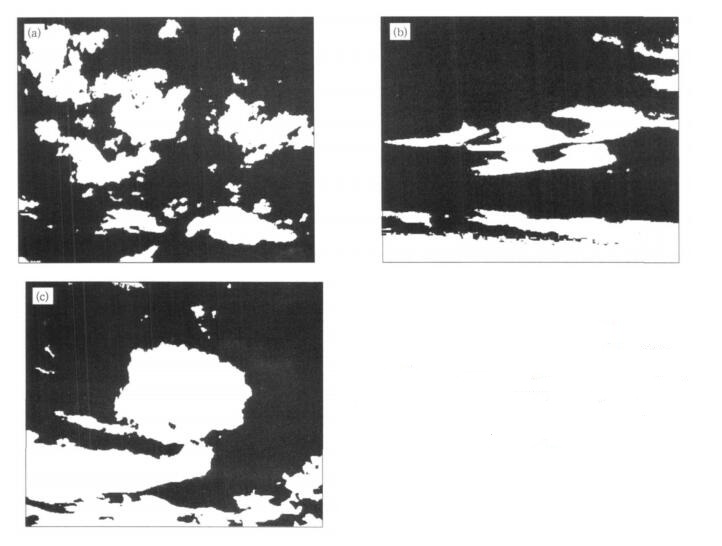基于自适应阈值的地基云自动检测方法
An Automatic Ground-based Cloud Detection Method Based on Adaptive Threshold
-
摘要: 云的高精度检测是云量计算的基础,利用晴朗天空下天空呈蓝色、云呈白色的属性, 该文提出一种基于最大类间方差的自适应阈值云检测方法, 并分别基于蓝红波段比值、差值和归一化差值处理进行试验。相比固定阈值的云检测方法, 自适应阈值具有更大的通用性, 且定量的评估结果表明:归一化差值处理在云检测的正确率和精确度方面都获得了令人满意的检测效果。Abstract: Clouds affect the energy balance of the earth by means of absorbing and scattering radiation, and they have notable influences on global climate. It is very important to monitor clouds and there are several meteorological satellites providing sky-based large-scale scope clouds observations round-the-clock. However, the ground-based cloud observations mainly depend on visual judgments of the meteorological observers, which have become a bottleneck of automatic meteorological observation.Computing cloudage automatically is very important, and cloud detection is the basis of cloudage computation.Up to now, the mature ground-based cloud detection methods are still based on thresholds.For instance, the threshold 1.3 is recommended for ratio of ground-based blue band and red band observations. However, considering the complexity of clouds, a fixed threshold obviously cannot obtain satisfactory detection effect for different types of clouds. In clear sky, clouds are white against the blue background, so an automatic ground-based clouds detection method can be established in terms of the maximum interclass variance adaptive threshold selection. Ratio, difference, normalized difference of blue band and red band are calculated respectively, then bimodal distributing can be found in the image gray histogram, and then an adaptive threshold can be obtained using the maximum interclass variance method. Compare the band operation result with the adaptive threshold pixel by pixel, a pixel whose gray value is less than the adaptive threshold can be regarded as cloud pixel, else non-cloud pixel.Using this rule, the cloud regions can be separated from the sky background.Three different types of ground-based clouds are analyzed, and the proposed adaptive threshold method performs more appropriately comparing with fixed threshold cloud detection method.The blue band and red band ratio method can detect the maximum cloudage, and the difference operation method can detect the minimum cloudage. But quantitative assessment results show that, the ratio method mistakes many non-cloud pixels into clouds, while the norm alized difference processing is satisfactory both in correctness and accuracy. It should be pointed out that the proposed method applies only to clear sky, as for other weather conditions, more researches are needed.
-
图 3 CI1 自适应阈值检测
(a)比值处理结果, (b)比值的自适应阈值检测结果, (c)差值处理结果, (d)差值的自适应阈值检测结果, (e)归一化差值处理结果, (f)归一化差值的自适应阈值检测结果
Fig. 3 Adaptive threshold detection for cloud image 1
(a)ratio operation, (b)adaptive threshold detection result of ratio, (c)difference operation, (d)adaptive threshold detection result of difference, (e)normalized difference operation, (f)adaptive threshold detection result of normalized difference
表 1 云检测精度评估
Table 1 Precision assessment for cloud detection

-
[1] Baum BA, Vasanth T, Tay T, et al. Automated cloud classification of global AVHRR data using a Fuzzy logic approach. JAppl Meteor, 1997, 36(11):1519 -1535. doi: 10.1175/1520-0450(1997)036<1519:ACCOGA>2.0.CO;2 [2] Bin T, Shaikh M A, Azimi-Sadjadi M R, et al. A study of cloud classification with neural networks using spectraland textural features. IEEE Trans Neural Networks, 1999, 10(1) : 138-151. http://ieeexplore.ieee.org/document/737500/?arnumber=737500&openedRefinements%3D*%26filter%3DAND(AND(NOT(4283010803)), AND(NOT(4283010803)))%26rowsPerPage%3D100%26queryText%3D(spectral%20data%20and%20neural%20networks%20) [3] Hulley GC, Hook S J. A new methodology for cloud detec-tion and classification with ASTER data. Geophys Res Lett, 2008, 35, L16812, doi:10.1029/2008G L034644. [4] 师春香, 瞿建华.用神经网络方法对NOAA-AVHRR资料进行云客观分类.气象学报, 2002, 60(2):250-255. http://www.cnki.com.cn/Article/CJFDTOTAL-QXXB200202016.htm [5] 刘希, 许健民, 杜秉玉.用双通道动态阈值对GMS-5图像进行自动云检测.应用气象学报, 2005, 16(4):434-444. http://qikan.camscma.cn/jams/ch/reader/view_abstract.aspx?file_no=20050454&flag=1 [6] 马芳, 张强, 郭铌, 等.多通道卫星云图云检测方法的研究.大气科学, 2007, 31(1):119-128. http://www.cnki.com.cn/Article/CJFDTOTAL-DQXK200701011.htm [7] 刘瑞云, 罗敬宁, 郭陆军.利用TOVS资料测雪.应用气象学报, 1999, 10(1):88-93. http://qikan.camscma.cn/jams/ch/reader/view_abstract.aspx?file_no=19990146&flag=1 [8] Davis G B, Griggs D J, Sullivan G D.Automatices timation of cloud amount using computer vision. J Atmos Ocean Technol, 1992, 9(1):81 -85. doi: 10.1175/1520-0426(1992)009<0081:AEOCAU>2.0.CO;2 [9] Souza-echer M P, Pereira E B, Bins L S, et al. A simple method for the assessment of the cloud cover state in high-latitude regions by a ground -based digital camera. J Atmos Ocean Technol, 2006, 23(3):437 -447. doi: 10.1175/JTECH1833.1 [10] Buch K A Jr, Sun C H , Thorne L R. Cloud Classification U-sing Whole-sky Imager Data. 9 th Symposium on Meteoro-logical Observations and Instrumentation. Charlotte , North Carolina , 1995 [11] Slater D W, Long C N, Tooman T P. Total Sky Imager/ Whole Sky Imager Cloud Fraction Comparison ∥ Eleventh ARM Science Team Meeting Proceeding.Atlanta, Georgia, 2001. [12] Kassianov E, Long C N, Ovtchinnikov M. Cloud sky cover versus cloud fraction:Whole-sky simulation sand observa-tions.J Appl Meteor, 2005, 44(1):86-98. [13] 霍娟, 吕达仁.全天空数字相机观测云量的初步研究.南京气象学院学报, 2002, 35(2):242 -246. http://www.cnki.com.cn/Article/CJFDTOTAL-NJQX200202014.htm [14] 霍娟, 吕达仁.晴空与有云大气辐射分布的数值模拟及其对全天空图像云识别的应用.气象学报, 2006, 64(1):31-38. http://www.cnki.com.cn/Article/CJFDTOTAL-QXXB200601002.htm [15] 霍娟, 吕达仁, 王越.全天空云识别阈值法的数值模拟初步研究.自然科学进展, 2006, 16(4):480-484. http://www.cnki.com.cn/Article/CJFDTOTAL-ZKJZ200604017.htm [16] Otsu N.A threshold selection method from gray level histo-grams. IEEE Trans Systems, Man and Cybernetics, 1979, 9(1):62 -66. http://ieeexplore.ieee.org/document/4310076/?reload=true&arnumber=4310076 [17] Shu felt J A.Performance evaluation and analysis of monocular building extraction from aerial imagery. IEEE Trans Pattern Analysis and Machine Intelligence, 1999, 21(4) : 311 -326. http://ieeexplore.ieee.org/document/761262/ -


 设为首页
设为首页 加入收藏
加入收藏



 下载:
下载:






